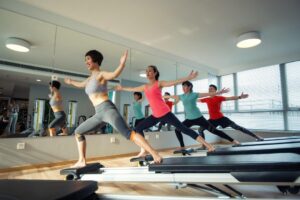Pilates, a form of exercise known for its focus on core strength, flexibility, and body awareness, has garnered acclaim for its effectiveness in improving posture. With a disciplined practice of Pilates, individuals can expect not just a workout that tones the body, but also one that aligns the spine and strengthens the back—all fundamental to achieving and maintaining good posture.
The Foundation of Good Posture
Postural alignment is at the very core of Pilates methodology. Exercises are designed to balance the muscles around the joints, fostering an even muscular tone and making it easier for the body to hold itself up with minimal strain. When muscles are equally strong and flexible, they support the skeletal structure efficiently, potentially reducing the risk of posture-related pain and injuries.
Pilates and the Spine
One key element of improving posture through Pilates is the spine’s alignment. Pilates emphasises the importance of moving the spine through its full range of motion—flexion, extension, rotation, and lateral flexion—which can lead to a more supple and functional backbone. This holistic approach ensures that all parts of the back receive attention and conditioning, contributing to a healthier posture.
Why a pilates reformer Can Help
The pilates reformer is a piece of equipment that amplifies the effects of Pilates exercises. Its system of springs, straps, and pulleys provides resistance, which can be adjusted to cater to different strength levels and to target specific muscle groups. This resistance challenges the body to maintain proper alignment while exercising, which is crucial for strengthening the muscles involved in maintaining good posture.
Deep Core Muscles and Posture
At the heart of Pilates exercises lie the deep core muscles, which include the transversus abdominis, multifidus, pelvic floor muscles, and the diaphragm. Pilates routines are centered on strengthening these muscles, which serve as the foundation for a strong back and good posture. These muscles create a ‘girdle of strength’ that supports the spine.
Addressing Muscle Imbalances
The cause of poor posture often resides in muscle imbalances. Certain muscles become tight and others weaken due to our lifestyles and daily habits. Pilates exercises are purposefully crafted to address these imbalances, promoting equal strength and flexibility across the body. This is particularly beneficial for those with sedentary jobs or lifestyles that contribute to slouched positions.
Benefits beyond the Back
While Pilates’ benefits for the back are significant, its advantages extend to the whole body. Improved posture aids in proper breathing and increases circulation, providing higher oxygen flow to muscles and better overall well-being. An aligned spine can also minimise the chances of disc problems and nerve compression.
Embracing the reformer pilates machine
Integrating exercises with a reformer pilates machine into one’s routine enhances the ability to develop a strong postural base. The machine is designed to cater to a range of postures, offering support to perform the exercises correctly without strain or injury.
Accessibility and Equipment
Pilates can be practised both in a studio or at home. While mat-based routines are effective, incorporating Pilates apparatus such as pilates equipment greatly diversifies the types of exercises that can be performed, adding variability and challenge to the workout regimen.
Being Consistent
Consistency is vital in experiencing the postural benefits of Pilates. Just as poor posture can develop over years of slumping and slouching, it takes time and regular practice to readjust and strengthen the body’s postural muscles. Pilates offers incremental progress that, over time, can result in significant improvements.
A Customisable Approach
Every individual’s body is different, and thus each person may require a different approach to improve their posture. Pilates can be tailored to an individual’s specific needs, focusing on their weaknesses and building on their strengths, offering a path to better alignment that is as unique as they are.
The Role of a Qualified Instructor
To maximise the benefits of Pilates for posture improvement, working with a qualified Pilates instructor can be invaluable. An instructor can ensure proper form and technique, reducing risk of injury and enhancing the efficacy of the exercises.
Conclusion
Pilates stands out as a methodical and highly effective way to align your spine and strengthen your back, which is fundamental in achieving good posture. By employing devices such as Pilates reformers and other equipment to challenge and support the body, individuals can work towards a well-aligned and healthily supported spine. Good posture is not only about aesthetic—it’s a gateway to overall health, and Pilates serves as an ideal guide to reach this crucial health goal.








